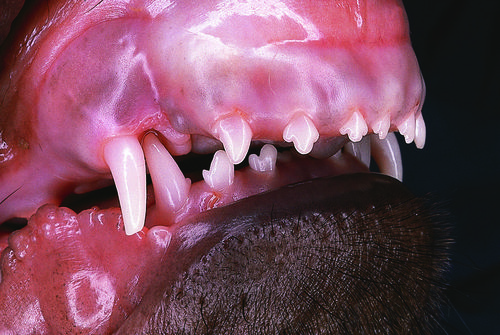Difference between revisions of "Veterinary Dentistry Q&A 09"
Ggaitskell (talk | contribs) |
|||
| (One intermediate revision by the same user not shown) | |||
| Line 1: | Line 1: | ||
| + | {{Template:Manson | ||
| + | |book = Veterinary Dentistry Q&A}} | ||
| + | |||
[[File:Vet Dentistry 09.jpg|centre|500px]] | [[File:Vet Dentistry 09.jpg|centre|500px]] | ||
| Line 13: | Line 16: | ||
The mandibular incisor teeth occlude against the incisive papilla and the mandibular canines are damaging the palate on the mesiopalatal aspect of the maxillary canines. | The mandibular incisor teeth occlude against the incisive papilla and the mandibular canines are damaging the palate on the mesiopalatal aspect of the maxillary canines. | ||
| − | |l1= | + | |l1=Dental Malocclusion |
|q2=What is the most common cause of this type of abnormality? | |q2=What is the most common cause of this type of abnormality? | ||
|a2= | |a2= | ||
| Line 19: | Line 22: | ||
These factors rarely cause dramatic, symmetric changes in the mandible alone. | These factors rarely cause dramatic, symmetric changes in the mandible alone. | ||
| − | |l2= | + | |l2=Dental Malocclusion |
|q3=Why is immediate treatment required, and what are the aims of treatment in a puppy? | |q3=Why is immediate treatment required, and what are the aims of treatment in a puppy? | ||
|a3= | |a3= | ||
| Line 29: | Line 32: | ||
Early relief of an abnormal dental interlock may permit the jaws to grow to their full genetic potential. It must be remembered that the genetic potential may be for further deterioration of, rather than an improvement in, the situation. | Early relief of an abnormal dental interlock may permit the jaws to grow to their full genetic potential. It must be remembered that the genetic potential may be for further deterioration of, rather than an improvement in, the situation. | ||
| − | |l3= | + | |l3=Dental Malocclusion#Treatment |
|q4=What is the most practical treatment in this puppy? | |q4=What is the most practical treatment in this puppy? | ||
|a4= | |a4= | ||
| Line 39: | Line 42: | ||
It is generally recommended that extractions are performed in a bilaterally symmetric pattern so that both sides of the jaw are equally influenced by the resultant changes in functional forces. | It is generally recommended that extractions are performed in a bilaterally symmetric pattern so that both sides of the jaw are equally influenced by the resultant changes in functional forces. | ||
| − | |l4= | + | |l4=Dental Malocclusion#Treatment |
</FlashCard> | </FlashCard> | ||
Latest revision as of 22:11, 13 October 2011
| This question was provided by Manson Publishing as part of the OVAL Project. See more Veterinary Dentistry Q&A. |
Developmental abnormalities are commonly seen in puppies.
| Question | Answer | Article | |
| Describe the abnormality shown in the photograph. | The puppy has a pronounced mandibular brachygnathism resulting in malocclusion of the deciduous dentition. The mandibular incisor teeth occlude against the incisive papilla and the mandibular canines are damaging the palate on the mesiopalatal aspect of the maxillary canines. |
Link to Article | |
| What is the most common cause of this type of abnormality? | Jaw length is determined primarily by heredity. The actual length attained by the jaw is also influenced by factors such as diet, metabolic disease, traumatic injury, infection, and both natural and artificial orthodontic forces. These factors rarely cause dramatic, symmetric changes in the mandible alone. |
Link to Article | |
| Why is immediate treatment required, and what are the aims of treatment in a puppy? | Palatal and incisive papilla contact by the mandibular canines and incisors leads to discomfort, ulceration, and pain. The abnormal dental interlock with the tips of the lower canine teeth embedded in the palate will also interfere with further growth of the mandible. The maxilla and mandible grow at different rates and may have growth spurts at differing times. Development of an abnormal dental interlock, whether simply due to eruption of teeth during a growth spurt or due to a jaw deformity, results in abnormal forces affecting the upper and lower jaws, restricting or enhancing growth depending on the direction of the forces. Early relief of an abnormal dental interlock may permit the jaws to grow to their full genetic potential. It must be remembered that the genetic potential may be for further deterioration of, rather than an improvement in, the situation. |
Link to Article | |
| What is the most practical treatment in this puppy? | Interceptive orthodontic extraction is the most practical treatment. It gives rapid relief from palatal trauma and removes the abnormal dental interlock. All the teeth which have an abnormal interlock or are causing palatal injury/irritation should be extracted, preferably by 12 weeks of age. Great care is required during extraction in order to minimize the risk of damaging the developing permanent tooth buds. A surgical approach is often preferable to closed extraction. It is generally recommended that extractions are performed in a bilaterally symmetric pattern so that both sides of the jaw are equally influenced by the resultant changes in functional forces. |
Link to Article | |
